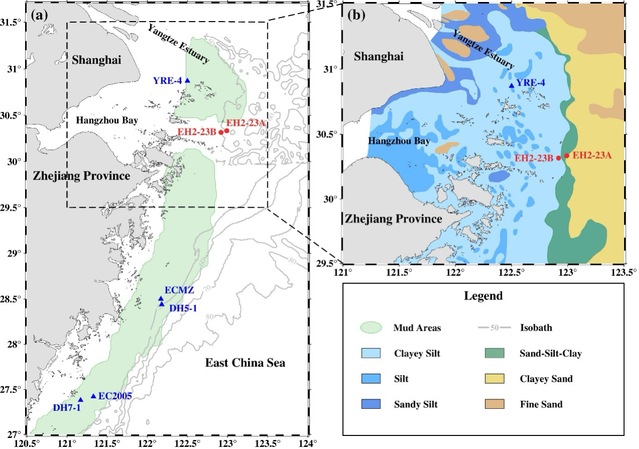- a
State Key Laboratory of Marine Geology, Tongji University, Shanghai 200092, China
- b
Laboratory of Marine Geology, Qingdao National Laboratory for Marine Science and Technology, Qingdao 266237, China
- c
- *
Key Laboratory of Yangtze River Water Environment, Ministry of Education, College of Environmental Science and Engineering, Tongji University, Shanghai 200092, China.
Corresponding author.
Abstract
The early diagenesis of iron is a critical component of the biogeochemical cycling within shelf sediments; however, its variability across different sedimentary environments has been less known. This study analyzed two sediment cores (EH2-23 A and EH2-23B) from the sand-mud transition zone of the East China Sea (ECS) shelf, with a focus on sediment grain size, total organic carbon (TOC) content, 210Pb and 137Cs dating, iron speciation and porewater chemistry. The results reveal that the upper section of EH2-23 A and the lower section of EH2-23B comprise palimpsest sandy sediments, while the middle section of EH2-23 A consists of relict sandy sediments, all of which are characterized by low TOC%, older ages, and limited contents of highly reactive iron (FeHR), indicating minimal diagenetic activity. The lower section of EH2-23 A features interbedded sandy and muddy sediments, shaped by fluctuating hydrodynamic conditions and influenced by submarine groundwater discharge. In contrast, the upper section of EH2-23B comprises younger, TOC-rich muddy sediments, where early diagenesis is predominantly driven by sulfate reduction. Sandy sediments consistently exhibit higher degrees of pyritization (DOP) compared to muddy sediments, reflecting prolonged diagenetic processes. Depth-dependent patterns of the ratios of FeHR to total iron (FeHR/FeT) and pyrite to FeHR (Fepy/FeHR) are classified into four distinct types. These findings contribute to a deeper understanding of early diagenesis and the C-S-Fe cycle in river-dominated shelf environments.
Full article:https://doi.org/10.1016/j.chemgeo.2025.122841

Figure : Study the column sampling positions of samples EH2-23A and EH2-23B and compare the column sampling positions

